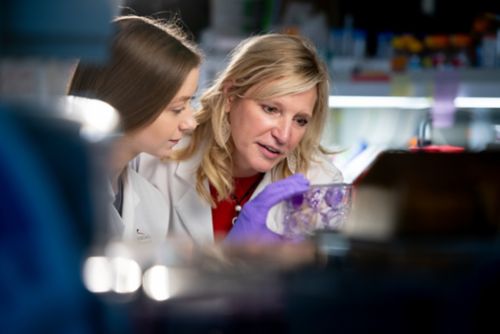St. Jude Family of Websites
Explore our cutting edge research, world-class patient care, career opportunities and more.
St. Jude Children's Research Hospital Home

- Fundraising
St. Jude Family of Websites
Explore our cutting edge research, world-class patient care, career opportunities and more.
St. Jude Children's Research Hospital Home

- Fundraising
Common astrovirus can lead to serious health problems

St. Jude scientist Stacey Schultz-Cherry, PhD, studies astrovirus, which in immunosuppressed or compromised patients can escape the intestines and get into the blood causing additional health problems.
You may have never heard of astrovirus, but you’ve more than likely been infected by it. Symptoms of most astrovirus infections are either absent or cause a case of diarrhea. But in certain people, especially immunosuppressed or immunocompromised children, astrovirus escapes the intestine and gets into the blood. This leads to viremia, where the virus has access to the rest of the body. My lab is interested in understanding how this virus, commonly associated with childhood diarrhea, can escape the gut and travel to the brain in kids (and potentially adults), causing severe disease. We want to know how it’s happening and what we can do to prevent it.
A better understanding of astrovirus
My work researching astrovirus began in the late 1990s. As an investigator for the U.S. Department of Agriculture-Agriculture Research Service, I identified astrovirus as a causative agent of poult enteritis mortality syndrome (PEMS) ; an outbreak that decimated the region’s commercial turkey population. Our investigation led to development of a great model to understand astrovirus pathogenesis that we use today. Important note: I am not fond of poultry—as a topic of research or main course.
Astrovirus is common and spreads through food and water. In fact, up to 90% of the population has been infected by age 9. The virus is a leading cause of disease in humans, other mammals, birds and even fish. In fact, it is one of the most frequently identified viruses, along with coronaviruses, in pathogen discovery studies. Despite its medical importance, astroviruses are understudied and underreported for several reasons. One, many infections go unreported and undetected because they are asymptomatic or result in a simple case of diarrhea. Another issue is that most molecular testing identifies only one of the three variations of the virus capable of infecting humans. Most of the human and mammal astrovirus variations don’t grow well in cell cultures, meaning it’s difficult to research the effects of treatment.
At St. Jude, we do have a test that identifies all three human strains. We also created a cell culture system and preclinical model of infection to investigate astrovirus and treatments. We were the first group to identify an antiviral drug that inhibits astrovirus infection, Nitazoxanide.
Astrovirus: from the gut to the brain
Our work has shown that children with cancer or other immunosuppressive conditions are more likely to get astrovirus infection, especially kids with hematological malignancies. This increases the risk of it going systemic and causing more severe problems, including encephalopathy and other central nervous system infections.
We know that one astrovirus genogroup, known as HMO or VA, is uniquely able to do this. In certain animals, including cows, sheep, mink and pigs, astrovirus VA/HMO infections are almost exclusively associated with encephalitis or meningitis.
A common thread in our infectious diseases lab is our interest in understanding viral pathogenesis, or mechanisms of disease, especially in high-risk populations. This includes researching astrovirus, influenza virus and microbial co-infections. We are also interested in how these high-risk hosts impact viral evolution and identifying treatments, whether vaccines or antivirals. We are now doing this for SARS-CoV-2.






